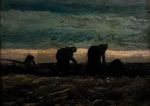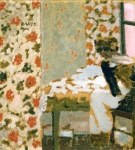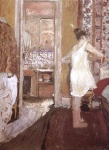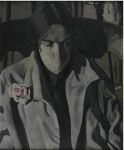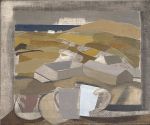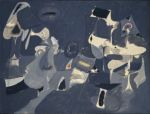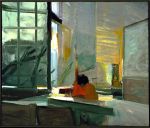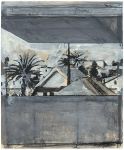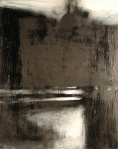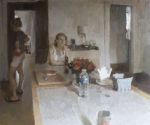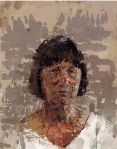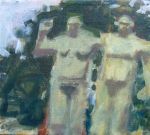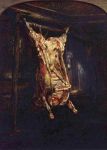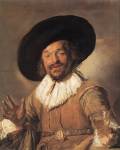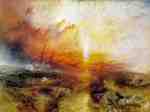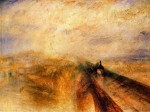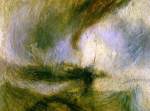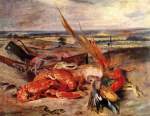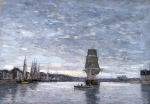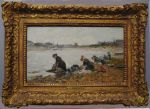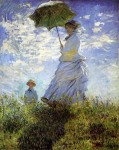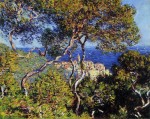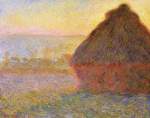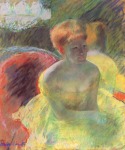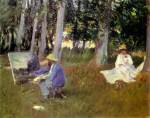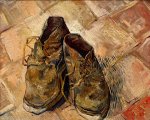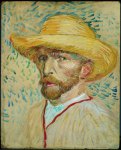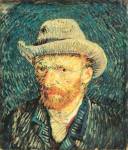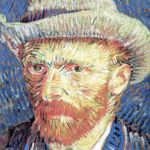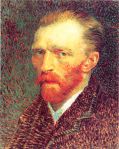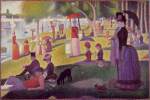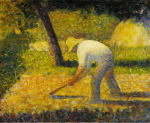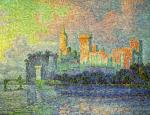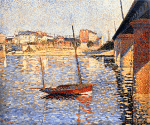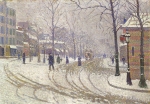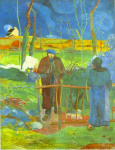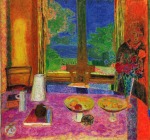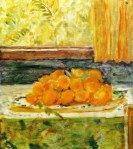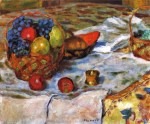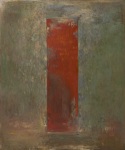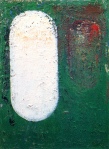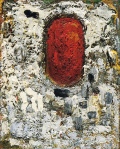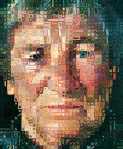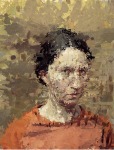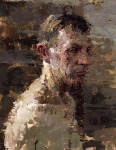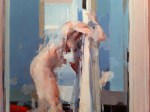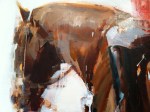Interior Motives
October 23, 2014 § 3 Comments
A gallery of interior paintings by contemporary and past masters.
Staying Neutral
March 7, 2014 § 3 Comments
Experience teaches us that limitation is the essence of creativity. Like a single flute playing in an echo chamber, the sounded notes of a few colors, a few shapes or lines set up visual resonances within the bounding space of the rectangle, multiplying complexity in unforeseen ways through their endless permutations. Using color in a limited way is a great way to explore this phenomenon. Here are some examples of works that choose to proscribe the range of color intensity, exploring the neutral zone that lies in the center of the color circle. Because of the relativity of color, the rainbow continues to assert itself but in a lowered intensity key. Color appears, not through pigmentation, but through optical relationships. Absence becomes presence.
Contemporary Figure Paintings
March 22, 2013 § Leave a comment
Every decade or so an article appears in the press proclaiming the return of the figure in art, implying that it somehow “went away.” In fact, the figure as a subject for painting never went away, and never will until the human race itself disappears. In a symposium on drawing several years ago at Randolph-Macon Womans College (now Randolph College) in Lynchburg, Virginia, I heard Janet Fish say, “Isms come and isms go, and the realists just keep painting.” (Or something to that effect.) Her statement could, I think, be applied accurately to the state of figure painting. Whatever the current obsession of the so-called art world, artists just keep painting the figure. Below is an album of some of the most compelling figure artists working today.
 Phil Geiger, figure study, oil on panel, 14″ x 10.” Collection of Frank Hobbs
Phil Geiger, figure study, oil on panel, 14″ x 10.” Collection of Frank Hobbs
The Beauty of Shapes
September 24, 2011 § Leave a comment
“We look up and see a coloured shape in front of us and we say – there is a chair. But what we have seen is the mere coloured shape. Perhaps an artist might not have jumped to the notion of a chair. He might have stopped at the mere contemplation of a beautiful color and a beautiful shape…” -Alfred North Whitehead
“Remember that a picture, before being a battle horse, a nude woman, or some anecdote, is essentially a plane surface covered with colors assembled in a certain order.” -Maurice Denis (1890)
How often we forget the simple truth of Maurice Denis’ statement as we peer into our three-dimensional world and try to “make” a tree, a face, a figure, or a teacup on our canvas. Annie Dillard’s essay on seeing, from a previous post on this blog, reminds us of just how far we’ve come from the infantile state of innocence when visual sensation was just “color-patches unencumbered by meaning.” The struggle to regain this innocent vision of color and shape is a large part of our “training” as artists. We want to be able to see our sensations, not just the things those sensations add up to, because this kind of seeing is what allows us to form questions that we can take to the palette. What is that hue? What is its tonal value? What is it’s degree of saturation or intensity? These three questions are the Holy Trinity of color mixing. (There’s a fourth, but we’ll save it for another post.)
But mixing color is only one piece of the puzzle. The color has to have a boundary or shape. This is the meeting place of drawing and painting. Stripped of the third dimension, the world’s forms and spaces precipitate two-dimensional shapes. Out of this distilled essence painters compose their paintings. Here are some painters who remind us of the beauty of shapes, all kinds of shapes. That’s what paintings are made of.
Some Contemporary Landscape Paintings
August 30, 2011 § 2 Comments
In memory of the summer just past, a selection of some of the great landscape painting being done today.
Ben Aaronson
Stuart Shils
Ryan Smith
Prilla Brackett
Chelsea James
Lois Dodd
George Nick
Philip Koch
John Virtue
Alex Kanevsky
Elizabeth O’Reilly
Israel Hershberg
Langdon Quinn
Antonio Lopez
Rackstraw Downes
Neil Riley
John Dubrow
Priscilla Whitlock
Phillip Geiger
Click the link to see the entire Contemporary Landscapes album.
An Interview with Alex Kanevsky
March 12, 2011 § Leave a comment
From Alive and Dangerous: Interview with Alex Kanevsky by Christopher Hill, February 27, 2011, blog post on Seems A House of Leaves. Click on the link to read the full interview.
“People always think that their paintings are defined by style. Style is a collection of your personal clichés, which don’t get you anywhere. Fashion designers need clichés because they need to have recognizable things. We actually need to have a direct connection between what you have inside and your painting. The moment something does not answer that need, you just discard it… It keeps things alive and dangerous, and that’s interesting.” –
Images from Alex Kanevky’s website:
“Le Petit Tache:” Divisionist Technique and Optical Mixing
February 7, 2011 § 5 Comments
Impressionist & Divisionist Technique
Landscape was the genre in which divisionist techniques were born and most developed, beginning with Turner and Delacroix who began to exploit the observations and theories of Chevreul and Goethe on the optical mixing of color by painting with distinct touches of unblended paint, side by side, allowing the color to “mix” in the eye.
The work of Turner and Delacroix, as well as that of Goethe and Chevreul in the early 19th century, had a profound impact on Monet, Pissaro, Sisley, Renoir, and others of the group that later became known as “Impressionists.” As students, their academic training taught them to shade forms off into brown and black in the shadows. These young painters could see that shadows were actually colored, and that, in fact, the whole visual field was shimmering with color sensation. Local color, the notion that things have a distinct, unchanging color, was shattered in the new awareness of how color, light, and context influence the perception of color. Their dissatisfaction with the limitations of academic teaching led them out of the studios into nature to work out a new way of painting based on the broken touch.
The technique itself was not new but its application was. The Impressionists built on an academic method widely taught in the ateliers of Paris known as the “petit-tache,” or little touch, a technique of applying unblended touches of color which later would be blended with a soft, badger-hair brush to disguise the effect and create a smoother, more refined look. The Impressionists were reviled, not only for their subject matter, which confronted every day realities of contemporary life as opposed to the classicizing conceits of academic painting, but also for exhibiting finished works with this broken touch, a direct confrontation to the tastes of the day. Seurat, and Signac developed the divisionist technique into the style known as Pointillism, based on their growing interest in the scientific application of color physics to painting.
Painters like Cezanne, Van Gogh, Gauguin, Serusier, Bonnard, and many others, were less interested in the science of color than they were in its emotional impact, and pushed color saturation into new subjective realms, developing very personal styles that derived from the use of the “petit-tache.”
- Rembrandt
- Frans Hals
- Frans Hals
- Turner
- Turner
- Turner
- Delacroix
- Boudin
- Boudin
- Monet
- Monet
- Monet
- Monet
- Cassatt
- John Singer Sargent
- Van Gogh
- Van Gogh
- Van Gogh
- Van Gogh
- Van Gogh
- Seurat
- Seurat (detail)
- Seurat
- Seurat
- Signac
- Signac
- Signac
- Signac
- Gauguin
- Serusier
- Bonnard
- Bonnard
- Bonnard
- Jake Berthot
- Jake Berthot
- Jake Berthot
- Chuck Close
- Ann Gale
- Ann Gale
- Alex Kanevsky
- Alex Kanevsky
- Alex Kanevsky






















































